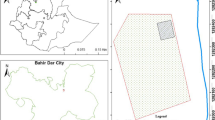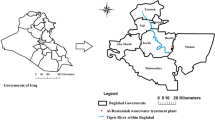Abstract
Among the various modeling techniques applied to dataset, multiple linear regression (MLR) analysis is the most efficient way to figure out the relationship between the response variable and the predictive variables. This study emphasizes on establishment of multiple linear regression models to analyze Biochemical Oxygen Demand (BOD) removal efficiency for technologies, namely Densadeck, Extended Aeration and Activated Sludge Process. Assumptions of multiple linear regression like linear relationship, multivariate normality, multicollinearity and Homoscedasticity were examined. The data that verify the assumptions were analyzed with multiple linear regression. Time series plots indicate drastic decline in BOD removal efficiency in the month of Feb and March during the years 2012 and 2013. This study was significant as it gives the technology having the best-fit regression equation based upon multiple correlation coefficient (R), coefficient of determination (R2), standard error, residual and F-ratio value. Societal benefits include enhancement in the performance of sewage treatment plants.





Similar content being viewed by others
References
Abyaneh HZ (2014) Evaluation of multivariate linear regression and artificial neural networks in prediction of water quality parameters. J Environ Health Sci Eng 12:1–8
Agirre BE, Ibarra BG, Madariaga I (2006) Regression and multilayer perceptron-based models to forecast hourly O-3 and NO2 levels in the Bilbao area. Environ Modell Softw 21(4):430–446
AI Gheethi AAS, Norli I, Kadil MOAB (2013) Elimination of enteric indicators and pathogenic bacteria in secondary effluents and lake water by solar disinfection (SODIS). J Water Reuse Desalination 3:39–46
AI Gheethi AAS, Abdul-Moneum MO, AL-Zubirey AHS, Efaq NF, Shamar AM, AI Amery RMA (2014) Effectiveness of selected wastewater treatment plants in Yemen for reduction of faecal indicators and pathogenic bacteria in secondary effluents and sludge. Water Pract Technol 9:293–306
Al-Gheethi AAS, Mohamed MR, Efaq AN, Norli I, Adib MR, Amir HMK (2017) Reduction of bacteria in storage system of sewage effluents. Sustain Water Resour Manag 3:193–203
American public health association (APHA) (1998) Standard methods for the examination of waters and wastewaters’, 20th edn. American Public Health Association (APHA), Washington, DC
Belhaj D, Jaabiri I, Turki N, Azri C, Kallel M, Ayadi H (2014) Descriptive and multivariable analysis of the water parameters quality of Sfax sewage treatment plant after rehabilitation. IOSR J Comput Eng 16:81–91
Coelho-Barros EA, Simoes PA, Achcar JA, Martinez EZ, Shimano AC (2008) Methods of estimation in multiple linear regression: application to clinical data. Rev Colomb Estad 31(1):111–129
Colmenarejo MF, Rubio A, Sanchez E, Vicente J, Gracia MG, Bojra R (2006) Evaluation of municipal wastewater treatment plants with different technologies at Las-Rozas, Madrid (Spain). J Environ Manag 81:399–404
DJB [Delhi Jal Board] (2015) Wastewater treatment technologies adopted at sewerage treatment plants, Retrieved June 2019 from https://elibrarywcl.files.wordpress.com/2015/02/sewage-treatment-and-technology.pdf
Dogan Ates, Yilmaz E, Eren B (2008) Application of artificial neural networks to estimate wastewater treatment plant inlet biochemical oxygen demand. Environ Prog 27:439–445
DPCC (2016) [Delhi Pollution Control Committee Report 2016]. Status of sewerage treatment plants in Delhi. [Internet]. c2018 [Cited July 2018]. https://www.dpcc.delhigovt.nic.in/down/5th_meeting_II
Fedotovai O, Teixeira L, Alvelos H (2013) Software effort estimation with multiple linear regression: review and practical application. J Inf Sci Eng 29:925–945
Ferraro MB, Giordani P (2012) A multiple linear regression model for imprecise information. Metrika 75(8):1049–1068
Hur J, Lee BM, Lee TH, Park DH (2010) Estimation of biological oxygen demand and chemical oxygen demand for combined sewer systems using synchronous fluorescence spectra. Sens Basel 10:2460–2471
Jamwal P, Mittal AK, Mouchel J (2009) Efficiency evaluation of sewage treatment plants with different technologies in Delhi (India). Environ Monit Assess 153:293–305
Kovdienko NA, Polishchuk PG, Muratov EN, Artemenko AG, Kuzmin VE, Gorb L, Hill F, Leszczynski J (2010) Application of random forest and multiple linear regression techniques to QSPR prediction of an aqueous solubility for military compounds. Mol Inform 29(5):394–406
Kumar R, Vaid U, Mittal S (2017) Water crisis: issues and challenges in Punjab. Water Resour Manag 78:93–103
Montgomery DC, Peck EA (1982) Introduction to linear regression analysis. Wiley, New York
Moustris KP, Nastos PT, Larissi IK, Paliatsos AG (2012) Application of multiple linear regression models and artificial neural networks on the surface ozone forecast in the greater Athens area, Greece. Adv Meteorol. https://doi.org/10.1155/2012/894714
Najah A, Elshafie A, Karim OA, Jaffar O (2009) Prediction of Johor River water quality parameters using artificial neural networks. Eur J Sci Res 28:422–435
Noller DG, Whitehouse GE (1982) Multiple linear-regression—a microcomputer application. Ind Eng 14:26
Parmar DL, Keshari A (2012) Sensitive analysis of water quality for Delhi stretch of the River Yamuna, India. Environ Monit Assess 184:1487–1508
Seung PL, Sang YM, Jin SK, Jong U, Man SK (2014) A study on the influence of a sewage treatment plant’s operational parameters using the multiple regression analysis model. Environ Eng Res 19:31–36
Sharma P, Khitoliya RK, Kumar S (2013) A comparative study of sewerage treatment plants with different technologies in the vicinity of Chandigarh City. IOSR J Environ Sci Toxicol Food Technol 4(5):113–121
Singh S, Singh N, Kumar S (2014) Quality of water in and around chandigarh region—a review. J Chem Environ Sci Appl 1:33–34
Vega M, Pardo R, Barrato E, Deban L (1998) Assessment of seasonal and polluting effects on the quality of river water by exploratory data analysis. Water Res 32:3581–3592
Wang ZM, Chen LD, Zhang HP, Sun RH (2014) Multivariate statistical analysis and risk assessment of heavy metals monitored in surface sediment of the Luan River and its tributaries, China. Hum Ecol Risk Assess 20:1521–1537
Yerel S, Ankara H (2012) Application of multivariate statistical techniques in the assessment of water quality in Sakarya River, Turkey. J Geol Soc India 79:89–93
Zihan L, Jin CJ, Sun HC, Namjoo H, Jungseok J, Jun WH (2018) Assessment of surface water quality in Geum River Basin, Korea using multivariate statistical techniques. Int J Appl Eng Res 13:6723–6732
Acknowledgements
We pay sincere thanks to Delhi Pollution Control Committee (DPCC) and Central Pollution Control Board (CPCB) for providing us relevant information regarding the various STPs in Delhi NCR. We also thank the anonymous reviewers for their constructive feedback and suggestions.
Author information
Authors and Affiliations
Corresponding author
Additional information
Publisher's Note
Springer Nature remains neutral with regard to jurisdictional claims in published maps and institutional affiliations.
Rights and permissions
About this article
Cite this article
Sharma, P., Sood, S. & Mishra, S.K. Development of multiple linear regression model for biochemical oxygen demand (BOD) removal efficiency of different sewage treatment technologies in Delhi, India. Sustain. Water Resour. Manag. 6, 29 (2020). https://doi.org/10.1007/s40899-020-00377-9
Received:
Accepted:
Published:
DOI: https://doi.org/10.1007/s40899-020-00377-9




